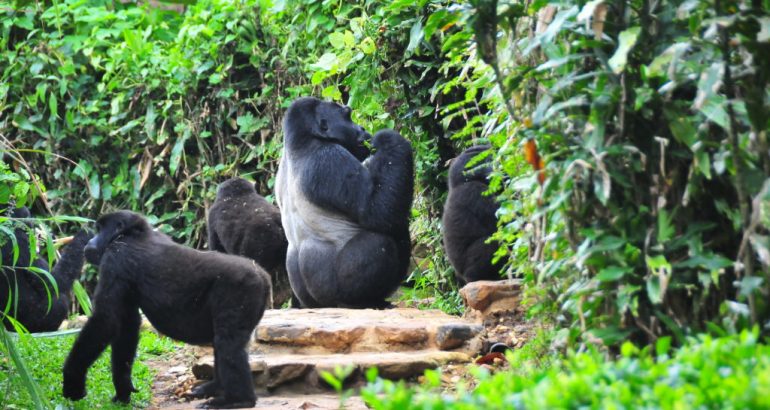
About
We pride ourselves on our passion for East Africa, her animals, wild spaces and Culture, amazing people.

© Copyright 2025 Nyumbu Beyond Journeys. All Rights Reserved

5 Inspiring Reasons to Embark on Gorilla Habituation
Deeper Understanding
Gorilla habituation allows for an in-depth exploration of gorilla behaviour, social structure, and ecology. Spending extended periods in their presence provides insights into their communication, feeding habits, territorial behaviours, and interactions within the group. Observing these aspects over time can lead to a richer understanding of gorilla societies and their role in the ecosystem.
Enhanced Conservation
Gorilla habituation directly supports conservation efforts by generating revenue for protected areas and local communities. Funds generated from habituation permits contribute to habitat protection, anti-poaching patrols, community development projects, and research initiatives focused on gorilla conservation. By participating in habituation experiences, visitors actively contribute to the preservation of gorilla populations and their habitats.
Immersive Experience
Unlike traditional gorilla trekking, which typically allows for one hour of viewing time, habituation experiences offer several hours of uninterrupted observation. This extended duration provides a more immersive encounter with gorillas, allowing visitors to witness a wider range of behaviours, such as grooming, playing, nesting, and foraging. The prolonged exposure fosters a deeper connection with these animals and their environment.
Unique Photo Opportunities
Gorilla habituation provides ample opportunities for capturing unique and intimate photographs of gorillas in their natural habitat. With more time for observation, photographers can document a variety of scenes, from tender moments between family members to dramatic displays of dominance by silverbacks. The ability to capture such moments in detail adds depth and authenticity to wildlife photography portfolios.
Educational Insights
Gorilla habituation experiences are often led by knowledgeable guides and researchers who provide valuable insights into gorilla biology, behaviour, and conservation. Visitors have the opportunity to learn about gorilla anatomy, social structure, reproduction, and the threats facing wild gorilla populations. Engaging with experts in the field fosters a deeper understanding of the complexities of gorilla conservation and the importance of preserving their habitats.
Personal Growth
Immersing oneself in the world of gorilla habituation can be a transformative experience on a personal level. It offers a profound connection to nature and wildlife, fostering a sense of wonder, empathy, and humility. Witnessing the beauty and resilience of gorillas in their natural habitat can inspire a deeper appreciation for biodiversity and a renewed commitment to environmental stewardship. Many visitors find that their time spent with gorillas leaves a lasting impact, shaping their perspectives and values long after the experience ends.
Memorable Encounters
Gorilla habituation provides opportunities for unforgettable encounters with these gentle giants. Whether it’s making eye contact with a curious juvenile, witnessing the strength and presence of a silverback, or observing the tender interactions between mothers and infants, every moment spent in the company of gorillas is filled with awe and wonder. These intimate experiences create lasting memories that resonate deeply with visitors, fostering a lifelong connection to these incredible animals and their conservation.
What to Pack for Gorilla Habituation Experience
Packing list for a perfect Gorilla habituation experience in Uganda.
When preparing for a gorilla habituation experience, it’s essential to pack wisely to ensure your comfort, safety, and enjoyment. Here’s a comprehensive list of items to consider bringing
Sturdy Hiking Boots
opt for waterproof, ankle-supporting boots with excellent traction. The terrain can be muddy, rocky, and uneven, so choose boots that can withstand such conditions.
Clothing Layers
Moisture-Wicking Base Layers: Choose breathable, moisture-wicking fabrics to keep sweat away from your skin.
Long-Sleeved Shirts and Pants: Protect yourself from scratches, insect bites, and sunburn by wearing lightweight, long-sleeved clothing.
Insulating Layers: Bring fleece or lightweight insulated jackets for cooler mornings or higher elevations.
Rain Gear: Pack a quality rain jacket and waterproof pants to stay dry during unexpected downpours.
Headgear
Wide-Brimmed Hat: Shield yourself from the sun and rain with a wide-brimmed hat to protect your face and neck.
Sunglasses: Invest in polarized sunglasses to reduce glare and protect your eyes from UV rays.
Insect Protection
Insect Repellent: Use a DEET-based insect repellent to deter mosquitoes, ticks, and other insects.
Permethrin Spray: Treat clothing and gear with permethrin spray for added protection against ticks and other insects.
Sun Protection
High SPF Sunscreen: Apply sunscreen with a high SPF rating to exposed skin, including your face, neck, and hands.
Lip Balm with SPF: Protect your lips from sunburn and chapping with a lip balm containing SPF.
Daypack Essentials
Lightweight Backpack: Choose a comfortable daypack with padded shoulder straps and a hip belt for distributing weight.
Water Reservoir or Water Bottles: Stay hydrated by carrying a water reservoir or multiple reusable water bottles.
Snacks: Pack energy-boosting snacks like trail mix, energy bars, fruits, and nuts to keep your stamina up during treks.
Camera Equipment: Bring a camera with a zoom lens to capture close-up shots of gorillas. Don’t forget spare batteries and memory cards.
Binoculars: Enhance your wildlife viewing experience by bringing lightweight, compact binoculars for observing animals from a distance.
Personal Items: Include essentials like a small towel, hand sanitizer, tissues, and any personal medications you may need.
Gorilla Habituation Guidelines: Rules and Regulations
Tourist listening attentively to their ranger about the dos and don’ts while on gorilla habituation experience.
As you embark on this extraordinary journey, it’s crucial to understand and abide by the essential guidelines and regulations that govern this immersive experience. Gorilla habituation offers a rare opportunity to observe and interact with these majestic creatures as they go about their daily lives in their natural habitat.
However, with this privilege comes the responsibility to ensure the safety and well-being of both you the visitors and gorillas alike. In this guide, we’ll delve into the rules and regulations designed to protect these endangered animals and enhance your adventure into the wild.
Respect Wildlife Distance
Maintain a minimum distance of 7 meters (about 21 feet) from the gorillas at all times.
Avoid approaching gorillas too closely, as this can cause them stress and disrupt their natural behaviour.
Follow the lead of your guide, who will ensure a safe distance is maintained between visitors and gorillas.
Follow Guide Instructions
Listen attentively to your guide’s instructions before and during the habituation experience.
Follow their guidance on how to behave around the gorillas and what actions to take in different situations.
Ask questions if you are unsure about any aspect of the experience.
No Flash Photography
Flash photography is strictly prohibited during gorilla habituation.
Turn off the flash on your camera and refrain from using any devices that emit bright lights, as they can startle or disturb the gorillas.
Use natural light or low-light settings on your camera for photography.
Stay Calm and Quiet
Keep noise levels to a minimum to avoid startling the gorillas.
Speak softly, if necessary, and avoid sudden movements that could alarm them.
Maintain a calm and relaxed demeanor throughout the habituation process.
No Feeding or Touching
Do not attempt to feed the gorillas or offer them any food, as it can disrupt their natural diet and behaviour.
Refrain from touching the gorillas, even if they approach you out of curiosity.
Respect their space and allow them to interact with their environment without interference.
Do Not Litter
Pack out all trash and litter from the gorilla habitat, including biodegradable items like fruit peels.
Dispose of waste in designated areas or carry it with you until you can properly dispose of it outside the park.
Stay with the Group
Remain with your guide and the rest of your group throughout the habituation experience.
Avoid straying from the designated path or wandering off on your own, as this can pose risks to both visitors and gorillas.
Limit Group Size
Gorilla habituation groups are typically smaller than those for gorilla trekking to minimize disturbance to the gorillas.
Follow group size limits set by park authorities and respect the capacity restrictions in place.
Respect Resting Gorillas
If gorillas are resting or sleeping, maintain a respectful distance and avoid disturbing them.
Keep noise levels low and refrain from approaching too closely until they are awake and active.
Avoid Direct Eye Contact
In gorilla communication, direct eye contact can be perceived as a threat or challenge.
Avoid making prolonged eye contact with gorillas, especially dominant males or mothers with infants.
Instead, keep your gaze downward or averted to demonstrate respect and non-aggression.
Follow Park Regulations
Familiarize yourself with all park regulations and guidelines established by the national park authorities where gorilla habituation takes place.
Adhere to any additional instructions provided by park staff or guides during the habituation experience.
Report Illness
If you are feeling unwell or exhibiting symptoms of illness, inform your guide immediately.
Visitors with contagious illnesses may be asked to refrain from participating in gorilla habituation to protect the health of the gorillas and other visitors.
By following these detailed rules and guidelines, you can contribute to a safe, respectful, and enriching gorilla habituation experience while supporting the conservation efforts aimed at protecting these incredible primates and their natural habitat.
We pride ourselves on our passion for East Africa, her animals, wild spaces and Culture, amazing people.

© Copyright 2025 Nyumbu Beyond Journeys. All Rights Reserved
